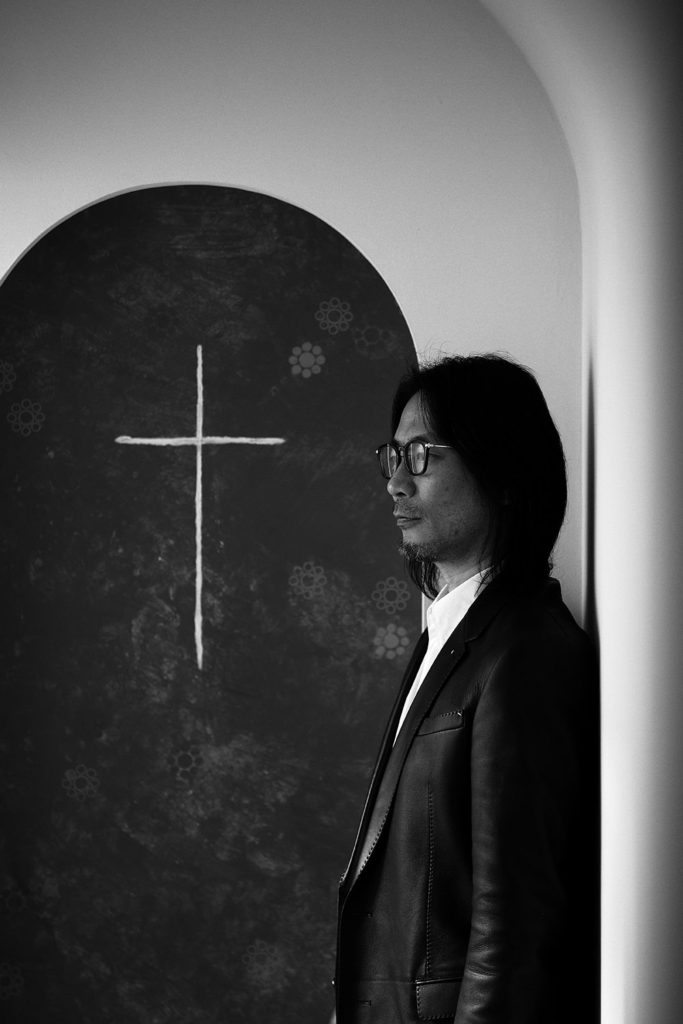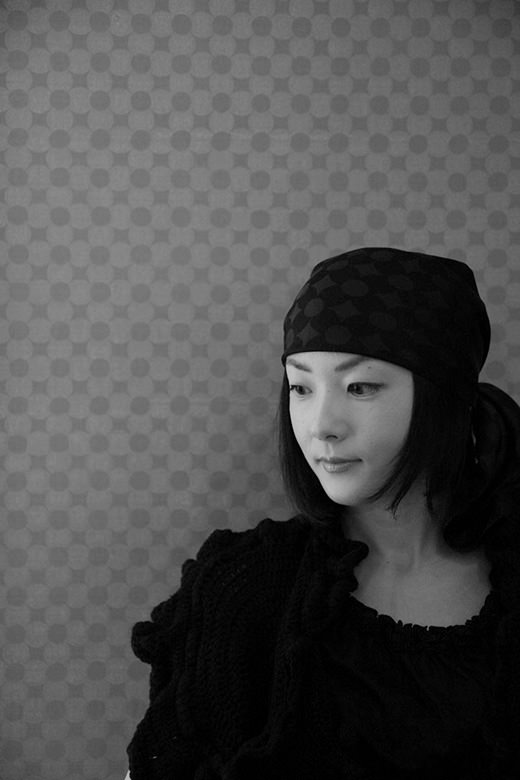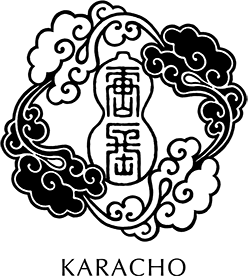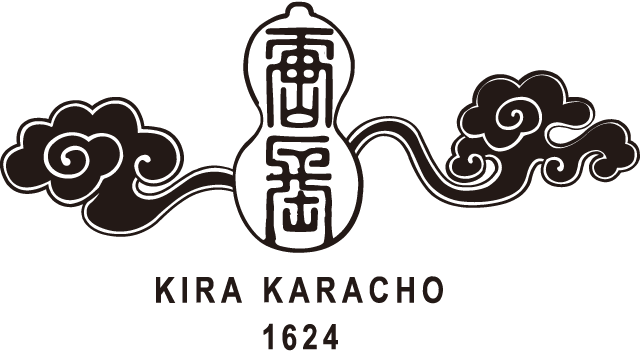Karakami-shi
Toto Akihiko

Karakami-shi—the karakami artist. From karakami-adorned sliding doors and fittings, to wallpaper, panels and lamps, we produce a variety of products that embody the traditional karakami of Karacho, designed to harmonize with your modern life. Toto Akihiko, the foremost figure turning karakami into art, has delved deep into the artistic quality of karakami and developed his own original techniques such as “Fuki (Wind Prayer)” and “shifuku printing,” which combines the painting techniques of pointillism and tarashikomi and involves the artist using his own fingers to apply his signature hues. Filled with the poetic sentiment created in concert with all the gods and spirits, the deep blue karakami works of art born of these original techniques are lovingly called “Toto Blue,” and their sacred colors create an exceptional blue world and story.
When his piece “inochi (life)” was exhibited at the MIHO MUSEUM, it garnered much attention as the first work of karakami to be featured as a museum piece, and in 2014, the first ever art exhibition of karakami was held at the Tokyo International Forum, Mitsuo Aida Museum. In 2020, Toto began work on a 22-meter-long karakami piece based on the theme of praying for world peace, the largest piece of karakami art ever created. The piece “Hoshi ni Negaiwo (Wish Upon a Star),” was dedicated to the famous Yogen-in Temple, where it is displayed alongside Tawaraya Sotatsu’s important cultural property “Karajishizu (Chinese Lion).” He has also worked on restoring the karakami on Tawaraya Sotatsu’s important cultural property “Matsuzu (Pine)” at the same temple, and has provided his pieces to Myoho-in Monzeki at Sanjusangen-do Temple, the nationally designated place of scenic beauty Murin-an, Go-o Shrine, and other places. Requests for karakami fly in from not only Kyoto but temples and shrines all over Japan. While inheriting and respecting the tradition of karakami culture since its inception during the Heian Period (794-1185), Toto Akihiko breaks out of the box and reinterprets it as a contemporary art form, opening a new, untrodden path for this historic craft.
In September 2015, he published his first written work, The Tales of Japanese Patterns (Kodansha), a compilation of his own spiritual words and photographs. In July 2018 he proposed a cultural endeavor to leave behind a treasure (spirit) for Kyoto 100 years in the future, and he also supervises the 100 Patterns of Heisei Project (since renamed the 100 Patterns of Heisei and Reiwa). With the ambitious goal of creating 100 new woodblocks to add to the more than 600 ancient artifacts that have been passed down from generation to generation since the Edo Period (1603-1867), Karacho will be responsible for the new legacy of the company. In April 2020, Toto and wife Aiko Senda published a newly written treatise on Japanese pattern stories and a brand storybook by Kira Karacho, The Patterns That Color Life: Artistic Life Book (Kodansha), which tells the past, present, and future of karakami. In July of the same year, Kira Kiracho Patterned Stationary Book (Seigensha) was also created.
| Spring 2008 | Produced “The Beauty of Karakami Karacho Exhibition” as an artistic activity, at Toraya Gallery in Tokyo Midtown. |
| Summer 2009 | Karakami “inochi,” a joint work by the husband-and-wife team, became the first karakami work to be acquired as an art form by a museum (namely MIHO MUSEUM). |
| Summer 2010 | “inochi” was displayed at “MIHO GRANDAMA Arte della Luce,” a special exhibition commemorating the 100th anniversary of the founding of MIHO MUSEUM. |
| July 2010 | Bunyu Exhibition held, a collaboration with calligrapher Ukyo presenting karakami complemented by calligraphy. |
| Fall 2010 | Karakami work of prayer, “Hoshi ni Negaiwo (Wish Upon a Star),” was dedicated to Yogen-in Temple. This work, which is displayed alongside Tawaraya Sotatsu’s Important Cultural Property “Karajishi” (Chinese Lion), became the first time karakami had been installed in a temple or shrine as a work of art. |
| 2010-2011 | Spent two years restoring the karakami paper of Tawaraya Sotatsu’s “Matsuzu (Pine),” an important cultural property, at the same temple. |
| End of 2010-January 2011 | Karakami exhibition at the JR Kyoto Station Gallery, MUSEUM EKi KYOTO, expressing the spirit of conjugal harmony. |
| Spring 2011 | “Inochinohikari (The Light of Life),” a joint work of karakami by the couple, was installed in the prayer hall of Go-o-jinja Shrine, located west of the Kyoto Imperial Palace. |
| Autumn 2011 | Worked on karakami to be used for the first service to celebrate the completion of Hokin-ji Temple of the Myoshinji School of Rinzai Zen Buddhism in 350 years. |
| Winter 2011 | “inochi (life),” a glass work using karakami paper measuring over 4 meters, was installed in the entrance lobby of a luxury condominium. |
| Spring 2012 | Dedicated Karakami “inochi (life),” a joint work by the husband-and-wife team, to the entrance lobby of a building created by world-renowned architect I. M. Pei, famous for the glass pyramid of the Louvre Museum in France. |
| May 2012 | Worked on the restoration of the karakami used on the “Edo Hitomezu (Edo at a Glance)” folding screen restoration at Tokyo Skytree, the world’s largest sightseeing tower, to be exhibited on the TEMBO Deck. |
| Winter 2012 | In Kyoto in November and in Ginza, Tokyo, in December, Toto Akihiko presented a collaborative work of karakami and painting with artiste AKI. |
| December 2012 | Toto Akihiko created karakami Christmas ornaments with his wife to be exhibited at “Les Sapins de Noël des Créateurs” in France. They were also displayed at the Japanese venue along with Christian Dior, Jean Paul Gaultier, Louis Vuitton, and other esteemed brands. |
| Spring 2013 | Dedicated karakami three-panel folding screen works, “Hoshi ni Negaiwo (Wish Upon a Star)” and “Kikaze no Michi (The Way of the Seasonal Wind)” at Jishoji Temple (Ginkakuji Temple). |
| Spring 2013 | Presented the karakami four-panel folding screen work “Nehanzu (Nirvana)” at Daizenin Temple of Bukkoji Buddhist Temple as a collaborative work with the painter AKI. After the presentation, the work was shown to the public for a limited time in the lobby of the Kyoto Hotel Okura. The concerted work “Futakujaku (Two Peacocks)” was also dedicated to Bukkoji Buddhist Temple Daizenin. |
| September 2013 | First publication with Mitsuo Aida: Mitsuo Aida & Kira Karacho presents Luck-bringing Postcard Book: Happiness. |
| October 2013 | 24 panels of karakami were installed in the staircases from the basement to the second floor of the Comme Ca Stage Ginza store, and other settings such as on the walls of the elevators. On the second floor, an eight-panel folding screen over 7 meters long, “Hoshi ni Negaiwo Soten no Tsuki (Wish Upon a Star: Blue Sky Moon)” and “Kifu no michi (The Way of the Seasonal Wind)” were displayed. |
| February 2014 | Binding for the book Recommendation of Innocence (author: Sochoku Nagai). “Hoshi ni Negaiwo (Wish Upon a Star),” used as cover art, creating a distinctively beautiful book. |
| April 2014 | Delivered a karakami work to the Labor Delivery Recovery (LDR) section of Kawamura Ladies Clinic of the medical group Jin-aikai. This is the first karakami to be featured in a place where life comes into being. |
| September 2014 | “The Beauty of Karakami: The World of Akihiko Toto, A Melody of Mica – A Moment in 400 Years” was held at Mitsuo Aida Museum of Art. This was the first time in the long history of karakami that it had been exhibited as art at a museum. Toto Akihiko has paved an untrodden path as the ultimate karakami artist. |
| December 2014 | Karakami artwork “The Way of the Seasonal Wind” was established in the Wisteria Tea Room at Byodo-in in Uji, Kyoto. |
| January 2015 | Karakami artwork “Mizuha” delivered to Sleep Clinic Ginza. |
| March 2015 | Artwork for Fukuoka Assisted Residence Sakura Rikyu and karakami art for Cafe Kotohogi. |
| May 2015 | Worked on the karakami book cover for Kadokawa Sophia Bunko for Beautiful Things: A Collection of Essays on Art by Masako Shirasu. |
| June 2015 | Created the book cover for Kadokawa Sophia Bunko for Fleeting Things: a collection of essays on Prayer by Masako Shirasu. |
| September 2015 | The first essay by karakami artist Toto Akihiko was published, “The Tales of Japanese Patterns: Japanese Pattern Story” (Kodansha). |
| October 2016 | “The Circle of Light,” a work depicting the shimmering of the changing seasons, was installed in “French Dining Top of Kyoto” on the top floor of the Rihga Royal Hotel Kyoto. The longest karakami artwork in history at 34-meters-long, it forms a 360-degree rotating archway in the restaurant’s observation deck that changes as the diners’ tables circle around. |
| October 2016 | Supplied karakami to the Sanjusangendo head temple, Myuho-in Monzeki. |
| November 2016 | Karakami artwork “Mizuha” was installed in the entrance hall of Karasuma Oike Premist Kyoto apartments. |
| March 2017 | MIHO MUSEUM 2017 Spring Special Exhibition: In Search of the Beauty of Japanese Glass—The Bindeisha Collection—a 37-meter-long installation of karakami in the museum’s show window, an effusion of gems of art and karakami. |
| May 2017 | Karakami is installed on the entrance hall ceiling of Brands Kyoto Gosho Nishi, with karakami art works “Hoshi ni Negaiwo (Wish Upon a Star)” and “inochi (life)” on the walls. |
| October 2017 | Toto Akihiko completed karakami work at Hakugenzan Ryusenji Temple, Hongwanji sect of Jodo Shinshu, including in the inner sanctum of the main hall, spare room, and corridors. Also, the more than 5-meter-long “Hoshi ni Negaiwo (Wish Upon a Star)” karakami artwork was dedicated. |
| March 2018 | Karakami dedication in Murin-an, a famous scenic spot. |
| April 2018 | Received an award from Daisaku Kadokawa, the Mayor of Kyoto City, for contributions to the preservation and maintenance of cultural properties with the Murin-an Karakami Dedication. Daisaku Kadokawa OFFICIAL |
| July 2018 | In July 2018 proposed a cultural project to leave behind a heart treasure for Kyoto 100 years in the future. Also currently supervises the 100 Patterns of Heisei (and Reiwa) Project. |
| December 2018 | Special edition of Sunny Japanese Cuisine: A Moment in the Blue Grass Orchard; The Seasonal Beauty of Japanese Cuisine (Author: Sanae Nagasaka / Photo: Yoshihiko Ueda). The binding on the special edition is made of Japanese paper by Ichibei Iwano (Important Cultural Property, Echizen Hosho) and hand-printed karakami (umenomaru/white mica print on mica-dyed ground). |
| January 2019 | In collaboration with the French Maison Ladurée, we will launch a limited edition of six luxury treasure boxes worldwide. The first of these, the Karakami Treasure Box, will be on special display at the main Ladurée Royal store in its home in Paris. |
| November 2019 | Renovation of guest rooms at Rihga Royal Hotel Kyoto under the supervision of Kira Karacho. The special rooms have been aptly named “KIN-UN: Golden Cloud” and “GIN-GETSU: Silver Moon.” |
| December 2019 | Karakami provided for the front ceiling of the chapel of Muromachi Church of Christ in Japan. |
| February 2020 | The work “Universal Symphony” (Shinji Shumeikai Shoden/2020) was completed. The work, which was created on the theme of prayer for world peace from the first day of 2022, is a single piece of art with 24 panels, and at 22 meters in size, it is the largest work of art in the history of karakami. The blue bead at the center of the work shines with the beautiful crystals of prayer that Toto Akihiko worked on with 22,690 people. |
| April 2020 | Publication of The Patterns That Color Life: Artistic Life Book (Kodansha). |
| July 2020 | Kira Karacho Patterned Stationary Book (Seigensha) published. |
| November 2020 | Karakami artwork “Universal Symphony” is selected as the CD jacket design for Grammy Award-winning world-renowned saxophonist Paul Winter’s new album “Light of the Sun”. |
| August 2021 | Karakami artwork “Pine and Crane” delivered to the entrance hall of Kyoto Saiin at Bellagio Miyabi, with original patterned glass produced, supervised, and installed on the façade wall. |
| March 2022 | Karakami artwork “Mizuha (from lapis lazuli)” was selected as the CD jacket design for shinobue (Japanese bamboo flute) musician Kazuya Sato’s new work “○ en.” |
| May 2022 | Karakami donated to the Shujobo lodging restoration project at Mt. Hidehiko, one of the three most sacred places for mountain asceticism in Japan. |
| July 2022 | At Bellagio Miyabi, artwork provided for the entrance hall of Shijo Dori II. In addition to delivering the karakami piece “Mizuha,” Toto supervised the production of a light wall with original patterned tiles and patterned glass for the walls, and a tsuboniwa (very tiny) garden. |
| March 2023 | Karakami artwork “Universal Symphony” is exhibited at the MIHO MUSEUM Spring Special Exhibition “Beauty in Prayer: Universal Symphony.” |
Senda Aiko
The 13th (current) Karacho Studio Master

Senda Aiko was born into the family business Karacho, which was founded in 1624 and still flourishes today as the last remaining karakami maker in Japan. She inherited the business in Saga, Kyoto, accepting the challenge of being the next leader. Together with her husband Toto Akihiko, a karakami artist, she proposes beautiful spaces for food, clothing, and shelter that enrich people’s lives and make them happy through her intuitive use of patterns and color. Recognized by the 11th generation master as being the descendent who most fully inherited the DNA of Karacho, she exhibited an exceptional sense of color since her early childhood and has developed and leveraged her sensitivities to open new frontiers for Karacho beyond the traditional arena of wallpaper and fusuma (sliding door) paper, breaking out into cards as well.
With the theme of “Life with KIRA KARACHO,” she has taken advantage of her rich sensibility and enjoyed expressing the Karacho patterns, which have been carefully handed down from generation to generation by her ancestors, on materials other than Japanese paper, actively collaborating with others in the areas of clothing, food, and housing. Opened in 2004, the COCON KARASUMA building, with its facade featuring the Karacho pattern of “Tenpyo Ogumo” (The Great Clouds of Tenpyo), has become a landmark in Kyoto.
In September 2015, Senda Aiko’s first written work Time in Kyoto (Kodansha) was published. In April 2020, she co-authored the book The Patterns That Color Life (Kodansha), and in July 2020, Kira Karacho Patterned Stationery Book (Seigensha) was published, combining beautiful patterns and color schemes selected with Senda Aiko’s unique and outstanding sense of color.
In 2022, Senda Aiko inherited the family business Karacho from 11th master Senda Kenkichi, and became the 13th head of Karacho.
Biography of Senda Kenkichi, father of Senda Aiko, the current head of Karacho

